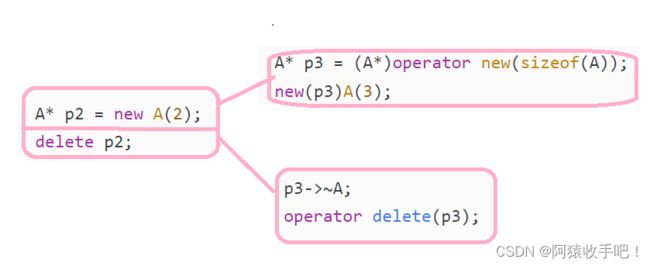C/C++内存管理
文章目录
- 1.C/C++内存分布
-
- 1.题目引入
- 1.2区域划分
- 2.C内存管理
- 3.C++内存管理
-
- 1.new--delete的初步认识
- 2.初始化
- 3.开辟空间失败
- 4.new--delete的类专属重载
- 4.有关面试题
-
- 4.1malloc/free和new/delete的区别
- 4.2 什么是内存泄漏,内存泄漏的危害
- 4.3内存泄漏分类
- 4.4如何避免内存泄漏
- 5.定位new表达式
- 6.new和delete的实现原理
-
- 6.1内置类型:
- 6.2自定义类型:
【本节目标】
- C/C++内存分布
- C语言中动态内存管理方式
- C++中动态内存管理
- operator new与operator delete函数
- new和delete的实现原理
- 定位new表达式(placement-new)
- 常见面试题
1.C/C++内存分布
1.题目引入
更清晰的认识一下
1.2区域划分
- 栈又叫堆栈:非静态局部变量/函数参数/返回值等等,栈是向下增长的。栈内存分配运算内置于处理器的指令集中,拥有很高的效率,但是分配的内存容量是有限的。
- 内存映射段是高效的I/O映射方式,用于装载一个共享的动态内存库。用户可使用系统接口创建共享共享内存,做进程间通信。
- 堆用于程序运行时动态内存分配,堆是向上增长的。一般由程序员自主分配释放,若程序员不主动不释放,程序结束时可能由操作系统回收。其分配方式类似于链表。
- 数据段–存储全局数据和静态数据。
- 代码段–可执行的代码/只读常量。代码段存放类成员函数和全局函数的二进制代码。
2.C内存管理
在C语言中的 动态内存管理 我们详细讲解了这部分内容。
#include<stdlib.h。
void* malloc(size_t size);
int* p = (int*)malloc(40);
void* calloc(size_t num,size_t size);
int* p = (int*)calloc(10, sizeof(int));
void* realloc(void* ptr,size_t size);
int* p = (int*)realloc(ptr, sizeof(int)*10);
3.C++内存管理
1.new–delete的初步认识
#include2.初始化
#define _CRT_SECURE_NO_WARNINGS
#include3.开辟空间失败
#define _CRT_SECURE_NO_WARNINGS
#include4.new–delete的类专属重载
① operator new 实际上是通过 malloc 来申请空间的。如果 malloc 申请空间成功就直接返回,否则执行用户提供的空间不足的应对措施,如果用户提供了措施就继续申请,否则就抛异常。
② operator delete 最终也是通过 free 来释放空间的。
链表演示C–C++
1.C语言
struct ListNode {
ListNode* _next;
ListNode* _prev;
int _val;
};
int main(void)
{
struct ListNode* n1 = (struct ListNode*)malloc(sizeof(struct ListNode));
if (n1 == NULL) {
printf("malloc failed!\n");
exit(-1);
}
n1->_next = NULL;
n1->_prev = NULL;
n1->_val = 0;
return 0;
}
2.C++
struct ListNode {
ListNode* _next;
ListNode* _prev;
int _val;
/* 构造函数*/
ListNode(int val)
: _next(nullptr)
, _prev(nullptr)
, _val(val) {}
};
int main(void)
{
ListNode* n2 = new ListNode(0);
return 0;
}
栈Stack演示
#include 内存池演示
#define _CRT_SECURE_NO_WARNINGS
#include4.有关面试题
4.1malloc/free和new/delete的区别
malloc/free和new/delete的共同点:
- 从堆上申请空间
- 需要用户手动释放
不同: - malloc和free是函数,new和delete是操作符
- malloc申请的空间不会初始化,new可以初始化
- malloc申请空间时,需要手动计算空间大小并传递,new只需在其后跟上空间的类型即可,多个对象[]中指定对象个数。
- malloc的返回值为void*, 在使用时必须强转,new不需要,因为new后跟的是空间的类型
- malloc申请空间失败时,返回的是NULL,使用时必须判空,new不需要,new需要捕获异常
- 申请自定义类型对象时,malloc/free只会开辟空间而new在申请空间后会调用构造函数完成对象的初始化,delete在释放空间前会调用析构函数完成空间中资源的清理.
4.2 什么是内存泄漏,内存泄漏的危害
- 内存泄漏:
因为疏忽或错误造成程序未能释放已经不再使用的内存。内存泄漏并不是指内存在物理上的消失,而是应用程序分配某段内存后,因为设计错误,失去了对该段内存的控制,因而造成了内存的浪费。 - 危害:长期运行的程序出现内存泄漏,影响很大,如操作系统、后台服务等等,出现内存泄漏会导致响应越来越慢,最终卡死。
void MemoryLeaks()
{
// 1.内存申请了忘记释放
int* p1 = (int*)malloc(sizeof(int));
int* p2 = new int;
// 2.异常安全问题
int* p3 = new int[10];
Func(); // 这里Func函数抛异常导致 delete[] p3未执行,p3没被释放.
delete[] p3;
}
4.3内存泄漏分类
- 堆内存泄漏(Heap leak)
堆内存:程序执行中通过malloc / calloc / realloc / new等,从堆中分配的一块内存,用完后必须通过调用相应的 free或delete 删掉。假设程序的设计错误导致这部分
内存没有被释放,那么以后这部分空间将无法再被使用,就会产生Heap Leak。 - 系统资源泄漏
程序使用系统分配的资源,比如:套接字、文件描述符、管道等,没有使用对应的函数释放掉,导致系统资源的浪费,严重可导致系统效能减少,系统执行不稳定。
4.4如何避免内存泄漏
- 工程前期良好的设计规范,养成良好的编码规范,申请的内存空间记着匹配的去释放。如果碰上异常时,就算注意释放了,还是可能会出问题。需要智能指针来管理才有保证。
- 采用RAII思想或者智能指针来管理资源。
- 有些公司内部规范使用内部实现的私有内存管理库。这套库自带内存泄漏检测的功能选项。
- 使用内存泄漏工具检测。
总结:
内存泄漏解决方案:
1、事前预防型。如智能指针。
2、事后查错型。如泄漏检测工具。
5.定位new表达式
定义:
在已分配的原始内存空间中调用构造函数初始化一个对象。
使用格式:
new *ptr type
new *ptr 初始化列表
使用场景:
配合内存池:内存池分配出的内存没有初始化,对于自定义类型的对象,需要使用new的定位表达式进行显示调构造函数初始化。
代码演示:

class A
{
public:
A(int a = 0)
: _a(a)
{
cout << "A():" << this << endl;
}
~A()
{
cout << "~A():" << this << endl;
}
private:
int _a;
};
int main()
{
此时构造函数没有执行
p1现在指向的只不过是与A对象相同大小的一段空间
还不能算是一个对象
A* p1 = (A*)malloc(sizeof(A));
new(p1)A; 如果A类的构造函数有参 此处需要传参
p1->~A();
free(p1);
A* p2 = (A*)operator new(sizeof(A));
new(p2)A(10);
p2->~A();
operator delete(p2);
return 0;
}
不带参定位new:
class A {
public:
A(int a = 0)
: _a(a) {
cout << "A(): " << this << endl;
}
~A() {
cout << "~A(): " << this << endl;
}
private:
int _a;
};
int main(void)
{
A* p = (A*)malloc(sizeof(A));
new(p)A;
return 0;
}
带参定位new:
class A {
public:
A(int a)
: _a(a) {
cout << "A(): " << this << endl;
}
~A() {
cout << "~A(): " << this << endl;
}
private:
int _a;
};
int main(void)
{
A* p1 = (A*)malloc(sizeof(A));
new(p1)A(10);
return 0;
}
6.new和delete的实现原理
6.1内置类型:
- new/delete申请和释放的是单个元素的空间
new[]和delete[]申请和释放的是连续空间 - new申请空间失败时抛异常,malloc返回NULL。
6.2自定义类型:
new的原理:
- 调用operator new函数申请空间
- 在申请的空间上执行构造函数,完成对象的构造
delete的原理
- 在空间上执行析构函数,完成对象中资源的清理工作
- 调用operator delete函数释放对象的空间
new T[N]的原理
- 调用operator new[]函数,在operator new[]中实际调用operator new函数完成N个对象空间的申请
- 在申请的空间上执行N次构造函数
delete[]的原理
- 在释放的对象空间上执行N次析构函数,完成N个对象中资源的清理
- 调用operator delete[]释放空间,实际在operator delete[]中调用operator delete来释放空间


